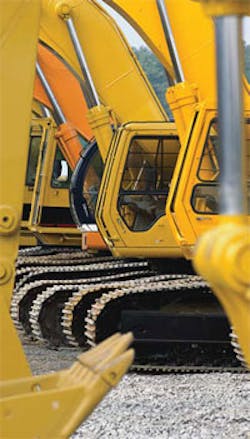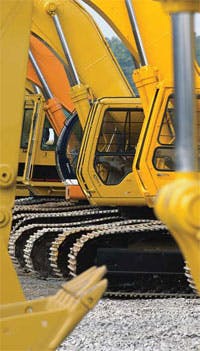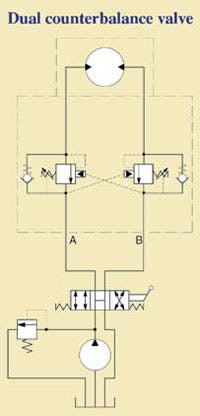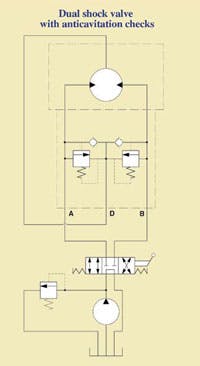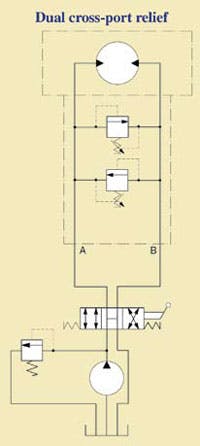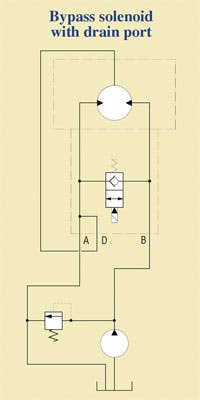Builders of construction and other off-highway equipment can now choose from four types of ready-to-mount hydraulic integrated circuits (HICs), designed to precisely fit seven popular low-speed, high-torque (LSHT) motors from Sauer Danfoss. This new fami ly of s tandardized, off-the-shelf HICs will ultimately speed up production timelines and reduce installed costs compared to using remote- mounted custom HICs.
These HICs perform several complementary functions common in LSHT motor applications. Four basic types of HIC valve functions, or schemes, are available: counterbalance (or overcenter), cross-port relief, bypass solenoid, and dual shock valve with anti-cavitation. Each of these is available in a variety of configurations to accommodate a wide variety of application requirments.
Counterbalance valves
Function — Counterbalance valves prevent motors from drifting excessively due to control valve leakage. They can hold the load in the event of hose/tube failure, or limit overrun when a load is in a lowering or runaway mode — or the vehicle is going downhill. They provide a smooth, cushioned stop when the control valve is suddenly closed.
An optional shuttle valve is available for functions such as load sensing feedback, operating an unloading valve, or releasing a brake. The shuttle connects the highest pressure port (A or B) to the S port. Configurations are available with dual counterbalance valves, or single valve on A or B port.
Without a counterbalance valve there is no backpressure to hold a load on the motor or to prevent free rotation when the control valve shifts to the neutral position. Additionally, without a counterbalance valve, there is nothing to prevent motor rotation in the event of hydraulic line failure.
Applications — Counterbalance applications typically include vehicle propulsion, swing drives, and winch drives. Many times winch drives will use a single valve configuration.
Dual shock valve with anti-cavitation checks
Function — This valve provides overpressure protection of the motor work ports. It absorbs momentary pressure spikes or shock effects. It is not a full-flow pressure relief valve. Full-flow pressure relief or torque limitation would require use of the dual cross-port relief HIC. The valve protects the motor from cavitation by allowing additional flow to the motor through the drain port when the motor overruns the pump.
A dual shock valve with anti-cavitation motor mount HIC is typically used in circuits where limiting the torque spikes from the load is critical, where the load is very dynamic, or where distance from the system relief valve causes delayed responsiveness.
Applications — Dual shock valves are useful in series wheel-drive applications where one motor must turn faster than the other while the vehicle is cornering. Other applications include auger drives, conveyer drives, slew drives, or any rotary working circuits that experience shock effects. The anti-cavitation function is also beneficial in high inertial load applications.
Cross-port relief valves
Function — The cross-port relief valve controls maximum torque of the motor. It provides overpressure protection for the work ports. The cross port relief valve is a full-flow relief. It can bypass all motor flow when pressure reaches the relief setting.
The cross-port relief valve is available in configurations with dual (cross-port) valves or with relief on A or B port only. An optional shuttle valve is also available for load-sensing pumps or auxiliary functions such as brake release.
Applications — Typical applications for cross-port relief valves include vehicle propulsion, auger drives, conveyer drives, and slew drives. Any rotary application requiring pressure limiting can benefit from a motormounted cross-port relief valve.
Bypass solenoid valves
Function — The bypass solenoid allows an electric signal to enable and disable motor rotation independent of system hydraulics. The normally closed solenoid valve bypasses flow from B to A when energized. This function is unidirectional with the option of reverse logic.
The manifold includes a drain port connected to port A to simplify circuit plumbing. Depending on motor drain pressure capabilities, the motor can connect to the motor drain directly to port D on the HIC instead of routing it back to the reservoir.
Applications — Typical uses for this valve include applications requiring individual motors on the same circuit to be turned off independently, when disabling the motor during system start-up to limit pressure losses, and on-off fan drive applications. A common example is a machine using a conveyor or auger systems.
Additional advantages
The prepackaged designs of the new motor mount HICs feature system plumbing and packaging efficiencies that not only decrease assembly time but also eliminate complex tubing and/or hose configurations. Users simply mount the appropriate HIC to the specified orbital motor using Orings and bolts included in the prepackaged kits.
For additional information, contact the author at (515) 239-6593, e-mail [email protected], or visit www.sauer-danfoss.com.
About the Author

Leaders relevant to this article:
